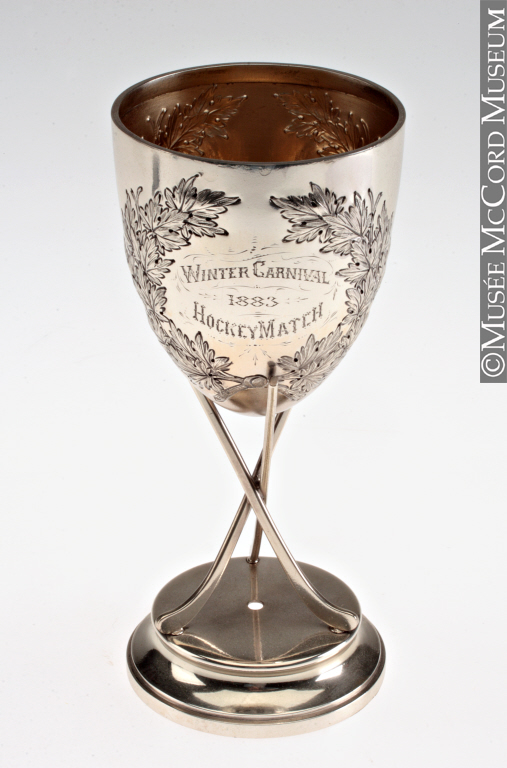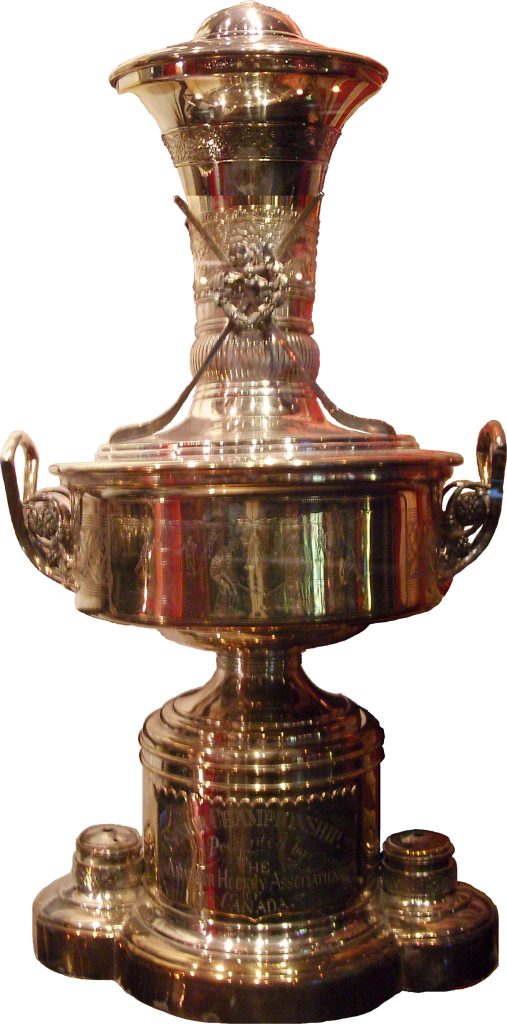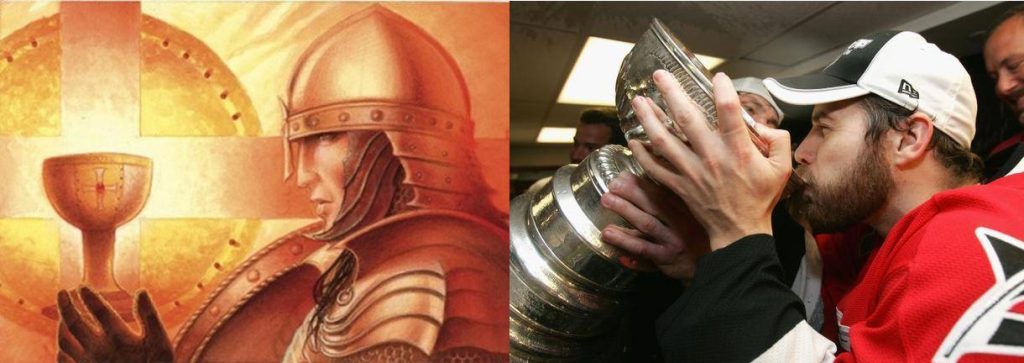Introduction
In 1893 (132 years ago) we see the establishment of ice hockey’s premier sporting trophy, the Stanley Cup! Yet Lord Stanley’s mug was not the first trophy awarded. The first hockey trophy and cup was awarded for winning the Montreal Winter Carnival Hockey Tournament, appropriately called the Carnival Cup.

When the AHAC was formed, it needed its own championship trophy and the league adopted a very ice hockey symbolized design with crossed hockey sticks defining it. It differed from the Carnival Cup by not being a cup and was appropriately called the Senior Championship Trophy.

Since the Senior Championship Trophy was property of the AHAC, a new trophy was needed to symbolize hockey supremacy across a growing sport of hockey and growing nation of Canada.
It was in December 1889 (136 years ago) Lord Stanley of Preston was first exposed to the game of hockey at Montreal’s 1889 Winter Carnival, where he saw the Montreal Victorias play the Montreal Hockey Club. That game made Lord Stanley of Preston as Governor General of Canada a highly enthusiastic fan for ice hockey.
His enthusiasm lead Stanley’s entire family to became active in ice hockey. Two of his sons, Arthur and Algernon, formed a new team called the Ottawa Rideau Hall Rebels. Arthur also played a key role in the formation of what later became known as the Ontario Hockey Association (OHA), and would go on to be the founder of ice hockey in Great Britain.
Arthur and Algernon persuaded their father to donate a trophy to be “an outward and visible sign of the hockey championship”. Stanley sent the following message to the victory celebration for the three-time OHA champion Ottawa Hockey Club:
“I have for some time been thinking that it would be a good thing if there were a challenge cup which should be held from year to year by the champion hockey team in the Dominion [of Canada].
There does not appear to be any such outward sign of a championship at present, and considering the general interest which matches now elicit, and the importance of having the game played fairly and under rules generally recognized, I am willing to give a cup which shall be held from year to year by the winning team.
I am not quite certain that the present regulations governing the arrangement of matches give entire satisfaction, and it would be worth considering whether they could not be arranged so that each team would play once at home and once at the place where their opponents hail from.”

So it was at the AHAC in 1893, the Dominion Hockey Challenge Cup (known today as the Stanley Cup) was to awarded to Montreal as its inaugural champion. The Cup would become the equivalent to a ‘World Series of Hockey’ as the best teams from Canada’s hockey leagues could challenge to win the Cup.
When the Dominion Hockey Challenge Cup was donated and competed for, there was officially and unofficially only amateur teams playing for it. As industrialization and wealth spread across North America, the desire to pay to see high level hockey took root and by 1909 we had an official split of professional and amateur hockey championships. The amateur teams formed their own league to play for the Allan Cup in 1909. The professional teams then challenged each other for the Stanley Cup. By 1926 the National Hockey League became the sole professional hockey league and the Stanley Cup became the league’s championship trophy. Today, the Stanley Cup is 132 years old and is considered to be one of sport’s top trophies. Hockey further cemented its love for Cups by having its top junior amateur leagues compete for the Memorial Cup in 1919 and having its top professional minor league compete for the Calder Cup in 1936 .
I speculate that ice hockey adopted the championship cup from Britain’s sports traditions. Canada was a British colony and adopted many of its social traditions including having a cup become its championship trophy. The British cup tradition is best enshrined in its football (soccer) league competing for the FA Cup every year since 1871.
It is not lost on me the shared symbolism of sporting campaigns leading to championship cups and heroic tales of knights questing for a chalice. The Stanley Cup, Davis Cup, America’s Cup and numerous World Cups are all now famous cup-shaped/themed trophies given to sport’s winners.
Our modern society keeps alive the symbolism of a Holy Grail (a carry-over from Arthurian literature) rewarding the cup finder happiness, eternal youth, or food in infinite abundance. Such an accomplishment becomes retold year after year, again not unlike legendary tales that are ritually retold.

Layer
Competition Summary
| Year | Dominion Hockey Challenge Cup Champion (League) |
|---|---|
| 1893 | Montreal Hockey Club (AHAC) |
| 1894 | Montreal Hockey Club (AHAC) |
| 1895 | Montreal Victorias (AHAC) and Montreal Hockey Club (AHAC) |
| 1896 | Winnipeg Victorias (MHA) and Montreal Victorias (AHAC) |
| 1897 | Montreal Victorias (AHAC) |
| 1898 | Montreal Victorias (AHAC) |
| 1899 | Montreal Shamrocks (CAHL) and Montreal Victorias (CAHL) |
Competition Championship Summary
# of seasons: 7
List of teams who won championships sorted by total days as championships.
The AHAC/CAHL was essentially the cup holders and the title of the cup would move over if a champ lost the regular season. So these are treated as cup wins and defend – go back and treat each season as a cup defense.
| Team (League) | Total Days as Champion | # of Cup Championships Won/Defended |
| Montreal Victorias (AHAC-CAHL) | 1,135 | 4 (1895-98) / 4 (1895, 1897-99) |
| Montreal Hockey Club (AHAC) | 720 | 2 (1893-94) / 2 (1894) |
| Winnipeg Victorias (MHA) | 320 | 1 (1896) / 0 (1896) |
| Montreal Shamrocks (CAHL) | 303 | 1 (1899) / 1 (1899) |
The Dominion Hockey Challenge Cup’s Legacy
The Dominion Hockey Challenge Cup (DHCC) would be the first Canada-wide hockey trophy where the best teams from the top leagues would challenge for its glory. The DHCC established the Stanley Cup as the premier elite trophy of hockey. Years later the professional hockey leagues would then compete for the Stanley Cup.
Future Features

